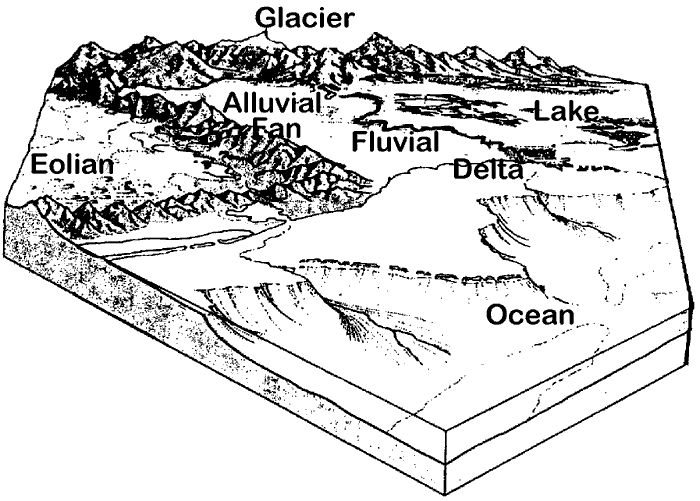BACKGROUND:
Sedimentary rocks form at the Earth’s surface from
clastic material
(pieces of other rocks or fragments of skeletons) which have become cemented
together, and by chemical mechanisms including precipitation and
evaporation.
There are many environments associated with sedimentary rock formation,
including oceans, lakes, deserts, rivers, beaches, and
glaciers. The diagram
shows several important sedimentary rock forming environments:

EOLIAN - Eolian refers sediment erosion, transportation, and
deposition by wind. Eolian environments are particularly common in deserts.
Sand dunes are an excellent example of an eolian feature.
ALLUVIAL FAN - Alluvium is the cover of soil, sand, and fine
grained rocks on the Earth’s surface. An alluvial fan is a large
fan-shaped pile of alluvium, deposited by a combination of stream and
landslide processes.
GLACIER - As they flow downhill, glaciers carry lots of loose rock
and debris. This material acts like sandpaper, and cuts away at the
underlying rock. Glacial sediment is deposited as the ice melts. Students
may not realize the power of glaciers.
FLUVIAL - Fluvial refers river environments. Water is very
efficient at eroding and transporting sediment. You may want to show
students pictures of different types of rivers.
DELTA - a delta is the sediment deposit that forms at the mouth or
a river, where it enters a lake or the ocean. Sediment is deposited as the
water slows down, producing an underwater fan shaped deposit.
PROCEDURE:
- Point out different sedimentary rock forming environments to the
students. Emphasize there are many environments in which sedimentary
rocks are formed, and that is why sedimentary rocks are very common on
the surface of the Earth.
- Go over the rock specimens before the students examine them. This will
help guide each student’s observational skills on the key
characteristics of each rock. Encourage them to use a hand lens or
microscope. In your review, point out the following:
CLASTIC SEDIMENTARY ROCKS - In general, produced from
broken particles that have been cemented together.
SAND: particles are separate, no cement
SANDSTONE: sand size particles that are cemented together;
individual grains are visible.
DIATOMITE: very small particles that are cemented together. These
are diatoms (one celled marine plant) and radiolarians (marine
protozoans). They are visible only with special microscope slides.
CONGLOMERATE: larger particles (pebble- or gravel- sized) that
are cemented together, coarse grained
MUDSTONE: very small particles cemented together, with no
biological ingredients, fine grained
CHEMICALLY DERIVED - Composed of precipitated minerals,
which grew out of water.
CHERT: red, hard, very fine-grained, cannot see any particles.
LIMESTONE: fizzes with dilute HCl, hard, generally cannot see
particles, although composed of fossils
Have the students look at the rocks above. The students should notice
that the chemically produced rocks do not resemble the other sedimentary
rocks. Conclude with the students that sedimentary rocks are sometimes
easy to interpret, sometimes not!
|